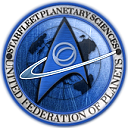Stardate 69010.5
Posted on 01 Feb 2019 @ 1:58am by Lieutenant JG Matthew Plumeri
Edited on 01 Feb 2019 @ 2:01am
933 words; about a 5 minute read
[ON:]
The shiny aluminum like lettering illuminated the LCARS display for a moment as the atmospheric sensor suite was brought online and in harmony with the Galileo’s sensor suite. When the animation was finished, Lieutenant JG Matthew Plumeri entered the coordinates into the computer display. In a flash, data started streaming in from the AURAE sensor suite. And it was stunning.
There, from the high orbital vantage point, Matt aimed the sensors at the destructive volcanic eruption that was spewing a now estimated 10 million tons of sulfur dioxide and ash particles into the air. Like a giant mushroom cloud of some horrific nuclear explosion the eruption spewed a cloud of noxious gasses, ashen dacite and deadly rhyolite nearly 20 kilometers (12 miles) high up into the atmosphere. There chemistry and the thermal dynamics of energy in the planet’s troposphere would, like a cancer, spread across the planet.
Lightning electrified by the forces from inside the planet now mixed with the charged atmosphere and formed grotesque, spidery veins that brilliantly flashed as the ash, the molten rock and pulverized crystals spewed with hellish rage into the air. The massive outpouring of gasses would change the patterns of weather itself on Ostara.
Matthew held onto the panel and felt sickened. The AURAE began its hours long analysis of the destruction, the killing of the atmosphere and it was not good. Matt read on the screen the data. Sulfuric gases were present, and they were converting to sulfate aerosols. Tiny sub-micron droplets that were mostly acid. They might linger for years to come as the sensors could already account for them forming in the stratosphere.
Matthew stepped back away from the monitor. As if being too close to it would singe his skin and burn his lungs. He covered his mouth and nose. As if he could smell the toxic rain that would come and kill every living thing for miles and miles.
The display pulled back to a large view, perhaps now 20 kilometers back. The cloud glowed from inside. Blood red and a hellish yellow. Sporadically, lightning seemed to rend the sky itself. He could see trees being sucked towards the rising cloud of ash and fire and death. The eruption was creating its own weather now. The column of gas and ash the AURAE clocked at hundreds of meters per second. And it was gorging itself on anything that it could find. Whole bodies of water boiled away and turned to vapor with nothing left.
In horror, Plumeri watched as the sensors pulled back further and the display showed the eruption from perhaps 50 kilometers away (35 miles). Ash was falling, piles of ash, scoria and lava bombs, miles from the eruption and pyroclastic density currents razed what forests there were. The soil was stripped and burned away from the bedrock as the molten rock obliterated – everything – in its path.
He slumped into the chair. Not even fifteen minutes had passed. He listened as the amazing atmospheric sensor gathered evidence of what was going on. He hung his head and closed his eyes a moment. Anything to temporarily block the reality that was happening on the planet below. It was not enough. He looked at the time remaining for a complete, global scan. The numbers in green read, “08:13:34”.
”Everything terrible is something that needs our love.” – Rainer Maria Rilke
Science Officer’s personal log, stardate 69010.5. Matthew Plumeri recording.
If I’m reading the astrometrics charts right, Latari B III is the third planet orbiting the Latari B star and that planet is named “Ostara”. I felt it important to learn the name of the place that is, right now, even as I speak, enduring one of the largest and most destructive volcanic eruptions I have ever seen. I don’t know why I volunteered to do the damn atmospheric scans. I’m not a meteorologist. I might know next to nothing about the atmosphere, but I know how to run the sensors. All this fancy, super, high tech gadgetry. It doesn’t help. I can’t get my mind off the colony that is supposed to be there. Eight hours we must wait before we can get enough data from the damn thing. I’m sorry. OK, I’m a little tense and I don’t want to sound unprofessional in a science log. But you got to know that all of this data…all of this data had better be of some damn use later. Otherwise, what’s the point of making bigger, better, faster…anything. It’s hard to be an observer when I am watching a planet and a whole ecosystem die. And not being able to do anything about it. This is my job, yeah. OK. I get that. Someone needs to run this thing and make sure that we get the most detailed scans we can get. I can do that. I just hope that at the end of this eight-hour horror show – I just hope its all worth it.
“Computer, end log and save it. What time is it anyway?”
The machine answered, “The time is 0630 hours.”
A cup of coffee swirled into existence from the replicator. Matt took the steaming mug and returned to the atmospheric sensors. The clock now read, “07:50:10”.
“It’s going to be a long day” he said and went back to work.
[OFF:]
Lieutenant JG Matthew Plumeri
Science Officer – Historian
USS Galileo-A
NCC-80010





 RSS Feed
RSS Feed